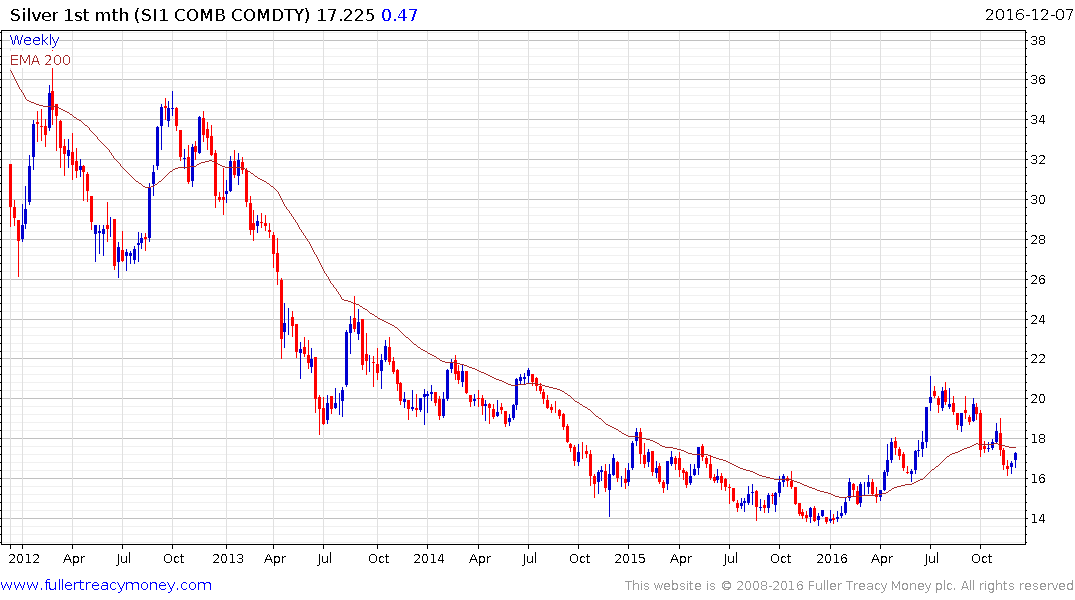Outlook for 2017: Better times ahead
Thanks to a subscriber for this report from Commerzbank which may be of interest. Here is a section:
According to a joint study by Thomson Reuters GFMS and the Silver Institute, the global silver market will record a supply deficit this year for the fifth year in succession. However, at 52.2 million ounces (1,623 tons), this is less than half what it was last year (chart 7). Silver demand should have fallen by 9% to a 4-year low of 1,064.6 million ounces (33,109 tons), while silver supply should fall by “only” 3% to 1,012.4 million ounces (31,486 tons). The biggest drag on the demand side is a 24% decline in demand for coins and bars. Jewellery demand is also expected to dip by nearly 8%. Industrial demand, which accounts for around half of total demand for silver, also declines, albeit only slightly. A steeper fall has been prevented by the rise in photovoltaics which is projected to have risen by 11% to a record level.
On the supply side, 2016 should see the first – albeit slight – fall in global mining production for 13 years (chart 8, page 5). This is because, following the closure of numerous zinc and lead mines, less silver is produced as a by-product. Due to liquidation of hedging positions (dehedging) by mining producers, additional supply has been withdrawn from the market. The supply of scrap silver, however, remained virtually unchanged. Owing to a significant rise in demand for silver ETFs – GFMS assumes net inflows of 71.4 million ounces (2,220.5 tons) for 2016 – and almost as large an increase in exchange-registered stocks, the broader market deficit has increased to 185.5 million ounces (5,769 tons). This is the highest figure since 2008.The deficit should turn out somewhat lower due to recent large ETF outflows, though.For 2017, Thomson Reuters GFMS and the Silver Institute except silver demand to decline by a further 3% to 1,035.0 million ounces. The supply of silver on the other hand should rise by around 1% to 1,024.8 million ounces. All demand components apart from jewellery are expected to decrease, with coins and bars once again falling the most, dipping by 9%. Industrial demand should fall by 2%, as demand from the photovoltaic sector – in contrast to the previous year – is also expected to decline, meaning that it can no longer compensate for persistent weakness in other sectors. Industrial demand would thus shrink for the seventh year in a row (chart 9). The increase in the supply of silver is almost entirely due to a larger supply of scrap silver, which should rise by 11% in response to higher prices. This will largely compensate for the accelerated decline in mining production by around 2% compared with the previous year. At the same time, de-hedging by silver producers will decline next year, meaning that less supply will be withdrawn from the market. Consequently, the deficit on the physical silver market is expected shrink to only 10.2 million ounces. This would be the smallest deficit since the last surplus year of 2012. ETFs are expected to record inflows of 40 million ounces. The broader market deficit would thus amount to 50.2 million ounces, a reduction of more than 70% compared with 2016.
Here is a link to the full report.
The bond market has priced in the return of some inflation, at least the kind central banks measure. However it has yet to appear in official statistics with the result that real interest rates have posted a rather large move. Precious metals tend to do best when inflation is outpacing interest rate increases (negative real interest rates) which is not currently the case. There is ample potential for inflation to pick up if fiscal stimulus is implemented next year which suggests there is scope for precious metals to regain some of their lost lustre next year.

Silver has been trending lower since July but in that time it has staged three rallies of between $1.50 and $2. It found support last week above $16 and another short-term rally is now underway. However a break in the progression of lower rally highs, currently near $19.20 will be required to signal a return to demand dominance beyond the short term.


